2 Unit 2: Rise of an Industry, The Weimar Era and German Expressionism
Part 1: Rise of an Industry
If you have studied any history from the industrial revolution you’ll know that patent disputes were very prevalent during this time period. Thomas Edison had the patent for the motion picture camera in the United States and once it was evident there was money to be made, he protected this patent. Of course, other inventors and filmmaker created new and differing motion picture technology to get around the patent, but soon The Motion Picture Patents Company was formed to form a monopoly on the movie industry. Read the linked article:
Important Filmmakers of the Silent Era
D.W. Griffith is often cited as one of the most important early American filmmakers. His film A Birth of a Nation was a massive hit and helped to reinvigorate the KKK and other racists organizations. Any discussion of Griffith is fraught with trouble regarding social issues, but his work as a director is important in the history of film. Griffith and his editors James and Rose Smith were famous for the seamless editing style that became the default method for Hollywood movie editing. Griffith and his cinematographer Billy Bitzer were some of the first filmmakers to shoot within the scene. Rather than carry out one long shot of the action, they cut from wide shot, to medium shot, to closeup, which would of course would become the classic style of shooting and editing in Hollywood for many years. You can see a classic example of this in Birth of Nation at the 42 minute mark of the film.
The Birth of a Nation (1915)
Was Griffith a racist? In this video, I attempt to explain why Griffith was Griffith and put his work into the sociological context of positionality.
Lois Weber
Like many early filmmakers Lois Weber was mostly lost in the dustbin of history, in this case intentionally so. Fortunately, the films of Lois Weber have found their way back into the history of cinema. Please watch this short piece from PBS on this fascinating filmmaker.
https://youtu.be/f3XSfM_4DVM
Oscar Micheaux
While there were many women working in Hollywood, Black filmmakers were few and far between. Black actors even had trouble getting work..Black roles were often played by Whites in Blackface. Filmmaker Oscar Micheaux was one of the few Black filmmakers working in the United States. Watch this short piece on Micheaux.
Studio History
Many people are surprised to learn that New Jersey and Chicago were the homes to motion picture production at the start of the industry. The very first film studio in the United States was the Black Maria built by the Edison Company. Watch this short video on the studio.
For the most part, movies were shot outdoors in order to have enough light to expose the film. Good weather is in short supply in Fort Lee, New Jersey and in Chicago, Illinois. As we learned with the patent disputes, filmmakers moved to California to avoid the Motion Picture Patents Company and the many days of sunshine and good weather were a boon to filmmaking. Please read this linked article on the development of Hollywood as a filmmakers paradise.Hollywood Studio History
Chicago was and is regaining its former glory as an important city for film production. The most notable Chicago studio was Essanay, where many of the early Chaplin films were made. Please read this linked article on Essanay Studios. History Essanay Studios
Part 2: Movie Theater Design
The first movies were shown in tents, vaudeville theaters and other places of public gathering. It was not long before movie viewing started to take off as a business. Edison’s Kinetoscope was patented in 1891 and may be the first place to watch a movie. You would lean over the machine and watch the short film through a viewfinder.
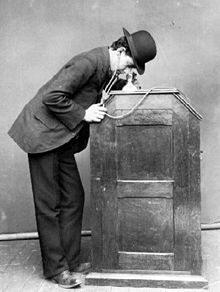
The Nickelodeon Theaters would quickly takehold, showing movies for you guessed it..a nickel.
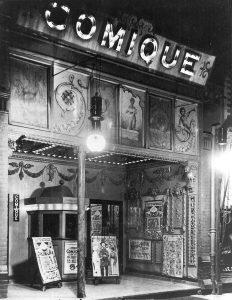
These theaters were often in converted stores and were popular from 1905 to 1915 when purpose built movie houses began to be built. Movies were becoming big business and building a theater became a hot investment idea. Purpose built movie houses became known as movie palaces due to their ornate architecture. Likely the first movie palace was The Strand in New York.
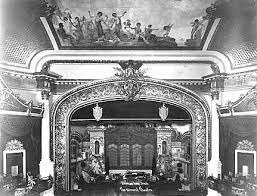
You can see that the theater had a very ornate design, with highly decorated ceilings. These ceilings were expensive to create and a new style of theater called an Atmospheric Theater was created to cut down on costs. These new theaters had decorative walls and lobbies but the ceilings were painted blue, and had twinkling lights to resemble the night sky. This design significantly reduced the cost of building a theater. An excellent example of the ornate ceiling movie palace can be found in Chicago, Il at the Chicago Theater. The Chicago was designed by Rapp and Rapp, a prominent architecture firm in the movie theater business. From the photo you can see the ornate French style architecture.
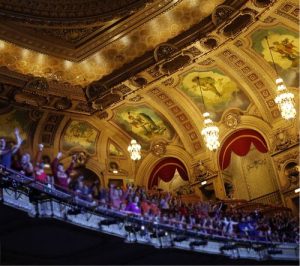
The movie business was seen a good investment of capital. One example of this is The Coronado in Rockford, Il. A group of investors who owned a piano company saw that piano sales were dropping with the popularity of movies and radio so they went into the movie business, eventually building their own movie palace. The Coronado was designed by Frederic Klein from Peoria and opened in 1927. The theater seats 2400 and today retains its functioning Grand Barton Organ. You can see the ornate design in the photos.
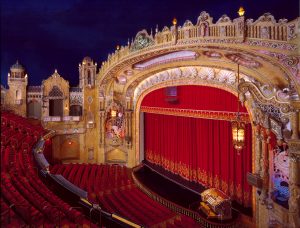
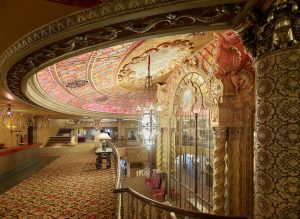
Theaters like The Coronado were very popular because of their ornate style. When you saw a movie, there would be an organist playing along with the silent film and in some cases a full orchestra. Of course, The Great Depression put a damper on movie ticket sales for a while and many of these theaters closed or were torn down. During World War Two, many theaters became gathering spots for War Bond Drives and a place that people could watch newsreels of the war. Post-war, the theaters suffered again because many people moved to the suburbs. These theaters were either torn down, closed, or turned into “adult” theaters. In the 1990’s and early 2000’s many of the remaining theaters have been restored and converted to symphony halls, ballet theaters and used for other entertainment venues. Throughout Chicagoland there are many movie palaces that are still showing movies and worth a visit.
Part 3: The Weimar Era and German Expressionism
The Weimar Era of German Cinema kicks off in 1912. To popularize German made cinema the government subsidized the creation of a national film studio Universum Film Aktiengesellschaft or UFA in 1917. A series of widely respected films came out of Germany in the early days including three we will discuss here : Nosferatu, The Cabinet of Dr. Caligari and Metropolis. Each of these films were a product of the adoption of expressionism
German Expressionism Films are a reflection of the outright rejection of World War 1 Germany. The German Empire had suffered a crippling defeat and there was no lack of despair in the society. If art is reflective of its surroundings, it is no surprise to see a series of dark, horror like films come out of Germany during this time.
The Cabinet of Dr. Caligari(1920)
While there were many non-expressionist films being made in Germany during this time, the three prior mentioned films are the most significant films. Robert Weine’s: The Cabinet of Dr. Caligari(1920) is often credited as the world’s first horror film. The film is often described visually as a nightmare, making use of dark shadows, jagged set set design and characters coming in and out of the shadows; some would even say it was a precursor to film noir . If you have seen any films by Tim Burton, you might find the set design and characters of Dr. Caligari to be very familiar…you might say Burton owes his career to Caligari.
Nosferatu(1922)
While Caligari might be the first horror film, Nosferatu (1922) kicks off what might be the most enduring genre of films: the vampire movie. F. W. Murnau started as a writer and later became a director. His film Nosferatu is of course based on Bram Stoker’s Dracula. Nosferatu is known for its dark lighting, pensive editing and innovative camera angles. It is an interesting film because if you speed it up to 2x speed it moves at a pace of modern cinema and the film can still frighten a modern audience. The film Shadow of the Vampire (2000) is an homage that posits the theory that Murnau hired a real vampire to play the part of Count Orlock. The homage is certainly worth watching after viewing Nosferatu.
Metropolis(1927)
Every cinephile has a favorite film from each era or movement and in the case of German Expressionism my favorite is Metropolis(1927). Fritz Lang had a steady career in the German Film Industry before making what many would call his masterpiece, Metropolis. If there was any doubt that German Expressionism was a rejection of the past and a statement about the future of Germany, Metropolis laid those doubts to rest. Metropolis clearly shows us the class struggle between the wealthy who have it and the poor who are merle cogs in the machine to make more for the wealthy. Today we might label it the same as the 1% versus the working poor. Metropolis feature lavish sets and heralds in a new era of science fiction films. When you watch Metropolis you see in it modern films such as Blade Runner, and The Fifth Element. Metropolis give us robots, flying cars, massive cities built with skyscrapers, and it gave UFA an enormous bill of over five million Reichsmarks. The film premiered at a length of 153 minutes and would be cut several times in subsequent versions. Film historians and preservationists have spent countless hours searching for lost segments of the film to restore it to its original condition. The current version was released in 2010 and is the most complete.
While there are plenty of other worthy German films and filmmakers of this period including G.W. Pabst, for our purposes, we will end here. Keep in mind that as we move out of the Weimar Era and into the Third Reich, most of the influential German filmmakers and stars would flee Germany for the United States and begin new careers in Hollywood.
